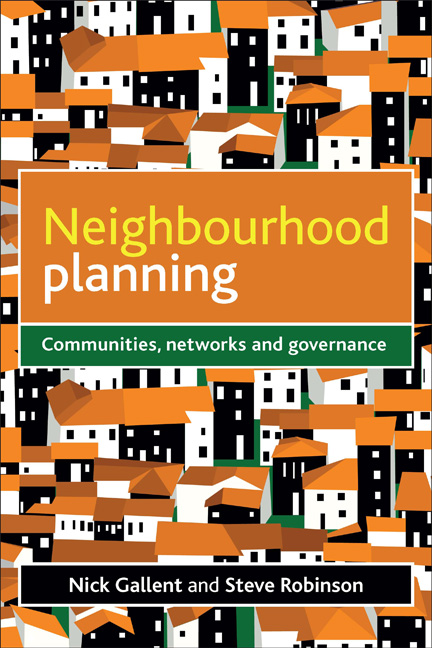Book contents
- Frontmatter
- Dedication
- Contents
- List of figures, images and table
- Abbreviations
- Acknowledgements
- Authors’ note
- Part One Democracy, planning and localism
- Part Two Capacity building and community-based planning
- Part Three The interface with policy actors
- Part Four Neighbourhood planning, leadership and democratic renewal
- References
- Index
one - Introduction
Published online by Cambridge University Press: 07 September 2022
- Frontmatter
- Dedication
- Contents
- List of figures, images and table
- Abbreviations
- Acknowledgements
- Authors’ note
- Part One Democracy, planning and localism
- Part Two Capacity building and community-based planning
- Part Three The interface with policy actors
- Part Four Neighbourhood planning, leadership and democratic renewal
- References
- Index
Summary
The Conservative–Liberal Democrat coalition government, in power since the UK General Election of 2010, has presented ‘localism’ as a clear alternative to over-centralised decision making – and as an antidote to dissatisfaction with existing democratic processes – to be delivered partly through a return of responsibility to ‘town halls’ and partly through a localisation of planning to the community, or ‘neighbourhood’, level. But localism is not a new concept and ‘modern’ community-based planning and activism have been around for many decades. Wherever neighbourhoods face the prospect of unsettling or disturbing change, or wish to grasp an opportunity, champions of ‘community interest’ will emerge, assuming or claiming the right of representation or mobilising support for a local response. In this way, structures of leadership take shape and the foundations for community planning are laid. The established apparatus of national and local government has not always embraced communities’ enthusiasm for a greater say in decision making, viewing neighbourhood groups as a hindrance rather than as partners in policy making. But in England in recent years, such groups have received a warmer welcome. Under recent Labour governments, the structures of community representation – especially parish councils – were actively promoted through a series of Local Government Acts, which gave tacit support to new community governance arrangements, and aimed to better connect them to policy making.
But during 13 years of Labour government, the expectations raised were not always matched by delivery. Planning and local government reforms seemed to take divergent paths, with the former centralising powers in regional and national bodies while the latter were laced with the rhetoric of ‘communities in control’. There was a perception that too many decisions were taken upstream, leaving local government and neighbourhood groups to squabble over detail while the big strategic decisions descended on communities from above. Government targets, including housing delivery targets, seemed to neutralise the potential of networked community governance, frustrating the ambitions of local people, politicians and professionals. All seemed to be of the view that something insidious was happening in Whitehall and the regional government offices; something that was inherently undemocratic. Such frustrations gave the Conservative Party an opportunity to popularise, again, its advocacy of a ‘small state’ and eventually bring forward a programme of reforms as the senior partner in the UK coalition government, indecisively elected to power in May 2010.
- Type
- Chapter
- Information
- Neighbourhood PlanningCommunities, Networks and Governance, pp. 3 - 8Publisher: Bristol University PressPrint publication year: 2012

